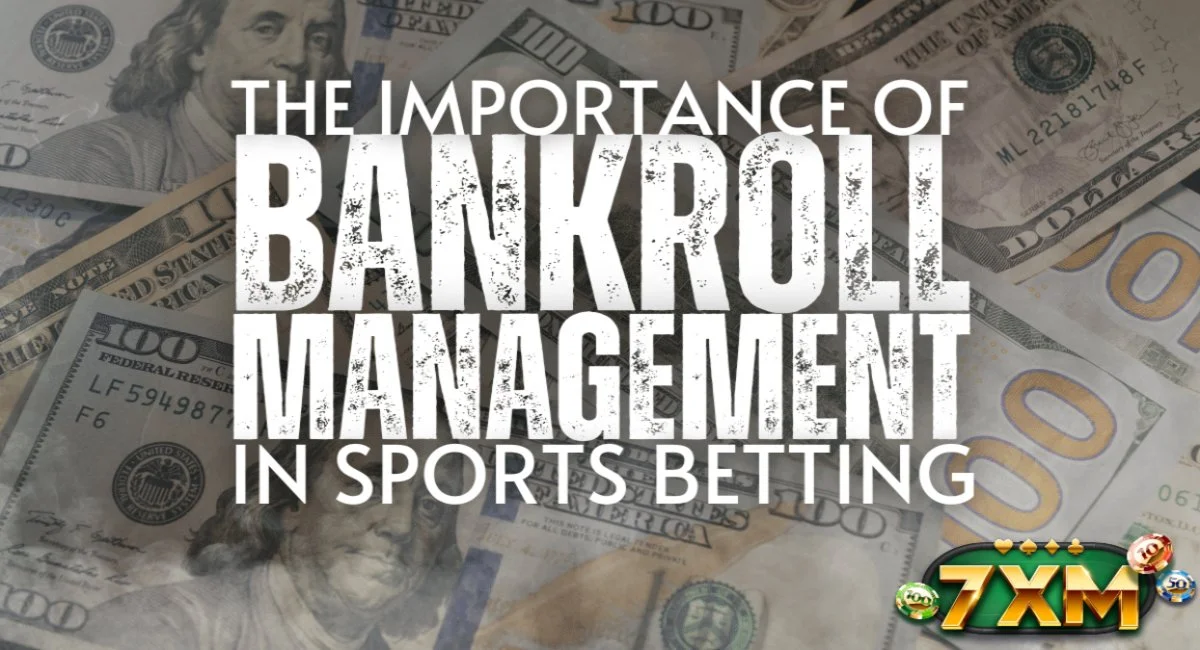Bankroll Management: What is it?
You need to know what bankroll means before you can read anything about bankroll management. The money that sports bettors set aside specifically for betting is known as their bankroll.
It’s common for sports bettors to set aside money specifically for placing bets. You must begin appropriate bankroll management as soon as you decide how much money you will gamble. Setting up some personal guidelines for the ideal distribution and utilization of the money for sports betting is all that’s required.

Bet tracking and units are the two main objectives of bankroll management. Your goals and the appropriate bankroll size can be attained by using various bankroll management strategies. Overall, bankroll management when betting increases your profits and keeps you out of the red. New and seasoned sports bettors alike are advised to use it.
Bankroll Management’s Significance
A bankroll management system and familiarity with the sportsbook are prerequisites for becoming a profitable sports bettor. A successful sports betting career also demands sound bankroll management skills. The difference between winning big and experiencing continuous losses is in your bankroll management. While there are numerous advantages to bankroll management, the following stick out:
- It reduces the possibility that you’ll lose your whole bankroll.
- Can Stop You From Chasing the Massive Win
- It helps you to endure an ongoing series of losses.
How Much Is Enough To Begin?
Knowing how much money you will have in your bankroll is the first step towards managing your betting bankroll. As previously mentioned, a bankroll is a money reserved specifically for betting. It would be ideal if you bet with rational thought and information, and the only way to achieve this is to divide your funds. What is the appropriate amount to add to your bankroll now that you have to set aside money for sports betting? It is contingent upon your existing financial circumstances. It is advised that you begin with a stake that you are willing to lose.
Select The Ideal Bet Amount For Every Bet
It’s time to think about how much to bet now that you have figured out your overall bankroll. Thus, your objective would be to gradually make a profit out of, say, a ₱500 total bankroll. This indicates that the money will be divided across several bets. You should be prepared to lose a few wagers while doing this before you start making some money.
Betting Approaches:
Conservative Betting
Conservative bettors typically wager 1% of their bankroll per bet. For example, if you have a ₱1000 bankroll, each unit size would be ₱10. This cautious approach minimizes the impact of losing streaks while steadily growing your winnings over time.
Conservative betting can be summarized in the following manners:
- The conservative bettor aims to minimize the number of losing bets taken.
- The conservative bettor opts for strategies with minimal volatility.
- The conservative bettor places wagers that are just sufficient, keeping them as small as required.
Aggressive Betting
On the other hand, aggressive bettors opt to wager 3% of their bankroll per bet. Using the same ₱1000 bankroll as an example, each unit size would be ₱30. While this strategy carries more risk, it also offers the potential for higher returns, allowing you to capitalize on winning streaks and make more significant gains.
Aggressive Betting can be summarized as follows:
- The aggressive bettor seeks to maximize the number of winning bets taken.
- The aggressive bettor opts for strategies with maximum volatility.
- The aggressive bettor places wagers that are as large as possible.
Regardless of whether you choose to be conservative or aggressive, consistency is key. Stick to your chosen unit size religiously, without deviating based on emotions or external factors. This disciplined approach will help you stay focused and avoid impulsive decisions that could jeopardize your finances.
Important Ideas
An effective bankroll management strategy is essential for in the long run, profitable sports betting. There are easy steps you may take to make good use of your cash. The most important rule is to never gamble with money you can’t afford to lose. It is also advisable to utilize units and record what you bet. The following are some useful guidelines to help you succeed:
Utilize Units
Sports bettors have long utilized units since they facilitate result comparisons between wagerers. This is because it is unfair to compare which gambler made more money when betting if they each had a ₱10,000 bankroll and another ₱1,000 bankroll. You can decide how much of your money you can bet by choosing a unit size. For example, you are up ₱500 and you have a unit size of ₱100, thus you are up five units.
Observe Your Bets
You will always need to keep track of your bets if you enjoy sports betting. Whichever technique you choose, it’s necessary to keep track of your bets. You will gain knowledge that will assist you in analyzing your performance by keeping track of your wagers. Additionally, it will enable you to distinguish between the sports that are increasing and decreasing your bankroll. The only way to find out all of this information is to monitor your progress.
Don’t Bring Emotions Into It
Similar to other gambling, there is always a chance of losing when placing a sports bet. It would therefore be wise to always hope for the best but be ready for the worst. Don’t place bets based just on emotion. Your favorite team does not guarantee that the bet you made will win just because that is the case.
Establishing a bankroll is among the most crucial steps before you begin betting. Make sure you never wager more than you can afford to lose. Since you have money put aside for everyday expenses, having a bankroll allows you to make well-informed decisions.
Make Wise Bets Based on Data
You should check the potential profit margin once you set aside funds for sports betting. Finding out a team’s historical performance data is essential to a long-term betting strategy. This should help you make an informed decision about which team is the best to put your money on. To put it briefly, before you make any bets, you must conduct a thorough betting analysis.
Strategies for Bankroll Management
Each game does not need bettors to use the same amount of money. You may manage your bankroll when betting on sports using several different strategies. You may manage your bankroll more effectively by using the tactics in this section. The variable stake, fixed unit model, and fixed stake are a few excellent examples. Wagering is most commonly done using the fixed stake bankroll management approach (fixed unit model). It just entails betting the same number of units on each bet you make.
Be aware that the amount of the bet may change due to other personal developments. The variable stake technique, on the other hand, entails figuring out the worth of your wagers. In this manner, you may put more money into a bet that offers more value. Other popular methods for managing your sports betting money are shown below.
Flat Betting
Among the easiest to use and long-term safest techniques is the flat betting strategy. You pick your unit size and bet one unit for each bet while using this sports betting technique. The level of certainty, style of betting, or odds are meaningless. Your only decision is whether to use the “risk” or “win” methods of action.
You can utilize the “to win” strategy for spread bets and the “risk method” for Moneyline underdogs. The choice that feels most comfortable for you, though, will ultimately determine the outcome.
Percentage
The fixed unit model is similar to this bankroll management strategy. The only distinction is that a percentage is used at the beginning of your bankroll rather than the same amount. For instance, the initial wager would have been 2% if your bankroll was worth ₱1,000 overall and you had one unit that was worth 2% of your whole bankroll. However, this figure could change every day. Your bet increases to ₱22 if your balance reaches ₱1,100. However, the amount you bet will decrease to ₱16 if it drops to ₱800.
By capitalizing on a winning run, the percentage model increases your chances of winning over time. However, it takes longer to recover from that if you lose more money.
Potential Return
While the potential return approach considers odds, the preceding two models primarily consider bankroll size. You attempt to win one unit per bet as opposed to wagering one unit every bet. Assume that team A is playing team B and that the odds are -110. In this scenario, you wager 1.10 units in instead of one unit, making the win 1.0. This model’s dramatic taking into account the fact that the favorite team wins more often and the underdogs lose more often is one of its advantages. More money is thus bet on the favorites. If you tend to back favorites with more luck, this model is ideal for you.
Bankroll Management Risks
You will run out of money if you bet an excessively high percentage. However, you could be losing a lot of money if you place a small proportion for a long period. Dividing players into three risk windows is the optimal approach to do this. Your willingness to take on risk and the size of your bets determine which risk window you are in. The larger the percentage of your bankroll that is appropriately put, the greater the risk you take. A look at the various risk windows is provided below:
- It is the safest option among the three, with a low-risk proportion of 0% to 2% bankroll. You will only make little profits, but your chances of running out of money are reduced.
- Those who take their betting seriously should have a bankroll with a neutral risk ratio of 0%–4%.
- For those who take their betting seriously, their bankroll’s high-risk range is 0% to 5%. This is the ideal window for you if you require a little extra risk.
Key Takeaways
- Effective bankroll management minimizes risk by spreading funds across multiple bets, reducing the impact of losses.
- Create a separate bankroll for sports betting, making sure it is an amount you can afford to lose without going broke.
- Bet between 1% and 5% of your total bankroll on any given bet to manage risk effectively.
- Resist the urge to raise bets to quickly recover losses, instead, stick to your set amount of bet.
Table of Contents



Related Posts:
- Sports Betting: The Premier Choice for Betting Enthusiasts!
- Betting Odds 101: Navigate the World of Betting with Ease!
- Betting Lines Made Simple: Essential Knowledge for Bettors
- Sports Betting Strategy: How to Win Big in Sports Betting!
- Moneyline: Everything You Need to Know to Start Winning
- Parlay Betting: Tips, Tricks, and Winning Formulas
- Over Under Betting: How to Win Big with Predictive Analysis
- Spread Betting: A Betting Game Changer for Big Winners
- Props Betting: A Guide to Your Consistent Wins!
- Futures Betting: Get Ahead on the Sports Betting Game!
- Raising Stakes for Big Wins: The Art of Online Gaming with 7xm
Bankroll Management Pros Vs Cons
Pros
It minimizes losses: Effective bankroll management makes sure you don’t lose all the time, which might eventually drain your bankroll. You will drastically lower the amount of time you lose to online bookies if you follow the directions carefully.
Helps in breaking losing streaks: While long-term negative trends may have an impact on your bankroll, prudent money management helps you strike a balance between your gains and losses.
It prevents you from aiming for the high score—let’s say you have won six straight and are feeling increasingly confident as your bankroll increases. Although you might be tempted to bet heavily on your next bet, bankroll management techniques can help you avoid doing so.
Cons
Poor bankroll management may lead you to lose your entire bankroll.
The probability of long-term financial success is limited.
Increasing Your Bankroll
Growing your bankroll over time is the ultimate goal of bankroll management and online sports betting. This involves increasing earnings, lowering losses, and reinvesting gains. To accomplish this, bet on games and markets that you are familiar with and knowledgeable about, conduct research and analysis before making bets, and assess the odds and offers from several sports betting sites.
Use 7XM bonuses and promotions sensibly while carefully reading their terms and conditions, and gain knowledge from reputable and informative online casino clubs.
In Conclusion
It’s your lifeline, so look after your bankroll. Select the betting approach that suits your needs and stay with it. You’ll be better if you get rid of skepticism and emotion from the betting process and are more consistent with it.
Learn where your handicapping strengths are by keeping track of all of your plays, deposits, and withdrawals. This may help you identify better edges, which may allow you to place larger unit bets.
Strong bankroll management techniques should be learned, adjusted, and maintained. Being a successful sports bettor involves more than just picking winners. The final aim of a positive ROI is determined by the way you handle your money.
FAQs
1. Why is bankroll management important in sports betting?
Bankroll management is crucial because it helps bettors minimize risk, maintain long-term sustainability, and exercise emotional control, ultimately enhancing their chances of success.
2. How much of my bankroll should I bet on each wager?
It’s generally recommended to bet between 1% and 5% of your total bankroll on any given bet. This helps manage risk and prevents significant losses during losing streaks.
3. What is the significance of setting a budget for sports betting?
Setting a budget ensures that you’re betting on money you can afford to lose without impacting your financial stability. It helps maintain discipline and prevents reckless betting behavior.
4. How do I avoid chasing losses in sports betting?
Avoid chasing losses by sticking to your predetermined unit size and resisting the urge to increase bet amounts in an attempt to recover losses quickly. Instead, maintain discipline and focus on making smart, calculated bets.
5. Should I adjust my betting strategy based on my bankroll size?
Yes, your betting strategy should be adjusted based on your bankroll size. As your bankroll grows or shrinks, you may need to reevaluate your unit size and overall approach to ensure it aligns with your financial situation and goals.


Leave a Reply